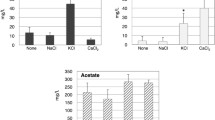Abstract
Rhodobacter capsulatus strain 37b4 was grown diazotrophically in phototrophic chemostat culture with 30 mM of d,l-malate and 2 mM of ammonium. Illumination was varied at constant dilution rate (D) and vice versa, respectively. When D was raised from 0.035 to 0.165 h-1 at 30 klx, the steady state cell protein level as well as malate consumption decreased. d-malate was utilized only at D=0.035 h-1. Specific cellular activities of nitrogenase, as determined by acetylene reduction as well as by dinitrogen (N2) fixation, increased and approached constancy at D>0.075 h-1. Specific ATP contents of cells increased with increasing D, while specific ADP and AMP contents exhibited no significant variations. Consequently, energy charge values as well as molar ratios of ATP/ADP (T/D) increased. Raising illumination from 6 to 30 klx at D=0.075 h-1 resulted in an increase of the steady state protein level as well as of l-malate consumption. d-malate was not utilized under these conditions. Specific nitrogenase activity of cells increased at the lower and levelled off at the higher illuminations. Specific ATP contents of cells stayed constant but specific ADP contents increased with increasing illumination. The energy charge did not vary significantly, while the T/C ratio decreased between 6 and 18 klx and stayed constant at the higher illuminations. The results do not reveal any relationship between nitrogenase activity and the cellular levels or relative proportions of different adenine nucleotides. However, when steady state amounts of fixed N2 were plotted versus steady state T/D ratios, an inverse proportion became apparent, irrespective of the growth conditions employed. On the other hand, specific nitrogenase activity increased linearly when the rate of malate consumption increased. The results suggest that under steady state conditions the T/D ratio reflects the amount of ATP required to keep the amount of fixed N2 at a given level, while the rate at which nitrogenase functions depends on the rate at which the carbon and electron source, malate, is utilized by the organisms.
Similar content being viewed by others
References
Appleby CA, Turner GL, Macnicol PK (1975) Involvement of oxyleghaemoglobin and cytochrome P-450 in an efficient oxidative phosphorylation pathway which supports nitrogen fixation in Rhizobium. Biochim Biophys Acta 387: 461–474
Arp DJ, Zumft WG (1983) Regulation and control of nitrogenase activity. In: Miller A, Newton WE (eds) Nitrogen fixation. Plenum Press, New York London, pp 149–179
Beloserski AN, Proskurjakow L (1956) Praktikum der Biochemie der Pflanzen. Deutscher Verlag der Wissenschaften, Berlin
Bühler T, Sann R, Monter U, Dingler C, Kuhla J, Oelze J (1987) Control of dinitrogen fixation in ammonium-assimilating cultures of Azotobacter vinelandii. Arch Microbiol 148: 247–251
Ching TM, Bergersen FJ, Turner GL (1981) Energy status, growth and nitrogenase activity in continous cultures of Rhizobium sp. strain CB 756 supplied with NH4 + and various rates of aeration. Biochim Biophys Acta 636: 82–90
Daesch G, Mortenson LE (1967) Sucrose catabolism in Clostridium pasteurianum and its relation to nitrogen fixation. J Bacteriol 96: 346–351
Davis LC, Kotake S (1980) Regulation of nitrogenase activity in aerobes by Mg2+ availability: an hypothesis. Biochem Biophys Res Commun 93: 934–940
Haaker H, Laane C, Hellingwerf K, Houwer B, Konings WN, Veeger C (1962) Short-term regulation of the nitrogenase activity in Rhodopseudomonas sphaeroides. Eur J Biochem 127: 639–645
Haaker H, De Kok A, Veeger C (1974) Regulation of dinitrogen fixation in intact Azotobacter vinelandii. Biochim Biophys Acta 357: 344–357
Klein G, Klipp W, Jahn A, Steinborn B, Oelze J (1991) The relationship of biomass, polysaccharides and H2 formation in the wild-type and nifA/nifB-mutants of Rhodobacter capsulatus. Arch Microbiol 155: 477–482
Laane C, Haaker H, Veeger C (1978) Involvement of the cytoplasmic membrane in nitrogen fixation by Rhizobium leguminosarum bacteroids. Eur J Biochem 87: 147–153
Lowry OH, Rosebrough NJ, Farr AL, Randall RJ (1951) Protein measurement with the Folin-Phenol reagent. J Biol Chem 193: 265–275
Ludden PW, Roberts GP (1989) Regulation of nitrogenase activity by reversible ADP-ribosylation. Curr Top Cell Regul 30: 23–56
Lundin A, Thore A (1975) Comparison of methods for extraction of bacterial adenine nucleotides determined by firefly assay. Appl Microbiol 30: 713–721
Lundin A, Hasenson M, Persson J, Pousette A (1986) Estimation of biomass in growing cell lines by adenosine triphosphate assay. Methods Enzymol 133: 27–42
Mortenson LE (1978) Regulation of nitrogen fixation. Curr Top Cell Regul 13: 179–231
Nordlund S, Höglund L (1986) Studies on the adenylate and pyridine nucleotide pools during nitrogenase switch-off Rhodospirillum rubrum. Plant Soil 90: 203–209
Paul TD, Ludden PW (1984) Adenine nucleotide levels in Rhodospirillum rubrum during switch-off of whole cell nitrogenase activity. Biochem J 224: 961–969
Postgate JR (1982) The fundamentals of nitrogen fixation. University Press, Cambridge
Steinborn B, Oelze J (1989) Nitrogenase and photosynthetic activities of chemostat cultures of Rhodobacter capsulatus 37b4 grown under different illuminations. Arch Microbiol 152: 100 to 104
Steinborn B, Juergens U, Oelze J (1991) Control of nitrogenase in chemostat cultures of Rhodobacter capsulatus grown on ammonium at different illuminations. Arch Microbiol 156: 135–141
Upchurch RG, Mortenson LE (1980) In vivo energetics and control of nitrogen fixation: changes in the adenylate energy charge and adenosine-5′-diphosphate/adenosine-5′-triphosphate ratio of cells during growth on dinitrogen versus growth on ammonia. J Bacteriol 143: 274–284
Vignais PM, Colbeau A, Willison JC, Jouanneau Y (1985) Hydrogenase, nitrogenase, and hydrogen metabolism in the photosynthetic baceria. Adv Microb Physiol 26: 155–234
Weaver PD, Wall JD: Gest H (1975) Characterization of Rhodopseudomonas capsulata. Arch Microbiol 105: 207–216
Willison JC, Maden D, Vignais P (1983) Increased photoproduciton of hydrogen by non-autotrophic mutants of Rhodopseudomonas capsulata. Biochem J 219: 593–600
Author information
Authors and Affiliations
Rights and permissions
About this article
Cite this article
Plikat, U., Dörffler, M., Steinborn, B. et al. Adenine nucleotides, substrate utilization and dinitrogen fixation in Rhodobacter capsulatus . Arch. Microbiol. 160, 406–410 (1993). https://doi.org/10.1007/BF00252229
Received:
Accepted:
Issue Date:
DOI: https://doi.org/10.1007/BF00252229




